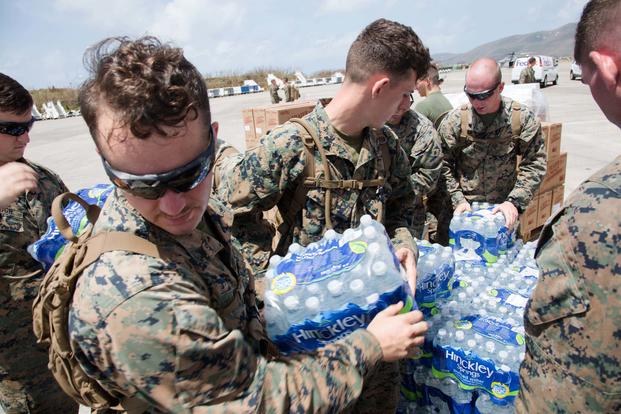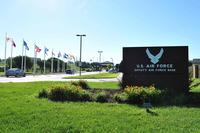ANNAPOLIS, Md. -- The Marine Corps and Navy responded in force to hurricanes in the Caribbean this summer, deploying two Marine expeditionary units aboard Navy amphibious ships and additional aviation elements to aid those affected by Hurricanes Irma and Maria.
But the weeks the 24th and 26th MEUs spent delivering humanitarian assistance in the Caribbean do not come without a cost, said Lt. Gen. Robert Hedelund, commanding officer of II Marine Expeditionary Force.
Speaking at the National Defense Industrial Association's Expeditionary Warfare Conference, Hedelund said II MEF is still taking stock of the impact of deploying ships that had not been scheduled to conduct operations.
"This [Defense Support of Civil Authorities] period this summer is going to have a huge impact on amphibious shipping for us," Hedelund said. "The Navy has gone way over the top on ensuring they can support that mission. But we're going to pay that price; we're going to pay that bill in availability in the months to come."
The 26th MEU raced to the Caribbean in early September, delivering supplies to the Virgin Islands and setting up a logistics hub close on the heels of Hurricane Irma. The unit, which returned from its previous deployment in April 2016, was conducting a months-long predeployment workup when it was called to the region.
The MEU spent roughly a month in the region, supporting aid to Puerto Rico as well. The unit delivered 390 pallets of food and water and cleared more than 65 miles of road while there.
But ultimately, Hedelund said, planners determined the ships should return to Camp Lejeune, North Carolina, to continue predeployment training.
"The clock is ticking ... so the 24th MEU comes back from their previous deployment, and they say, 'Hmm, not so fast, we need you to do some work for us here as a global response force,' " Hedelund said.
The 24th MEU had deployed from Lejeune in March with the Bataan Amphibious Ready Group, training and conducting operations in Europe and the Middle East.
On Oct. 11, instead of returning home, the unit conducted a relief-in-place to continue humanitarian aid efforts.
"They're a ready force," Hedelund said. "They're tired, no doubt about that, but they're a ready force, and we can send them off to do the nation's work, should it be needed."
Elements from the 26th MEU would still be on standby for storm efforts, however.
In early October, the commander of U.S. Fleet Forces Command, Adm. Phil Davidson, ordered the amphibious assault ship Iwo Jima and amphibious transport dock New York, with 26th MEU troops aboard, to position off the Gulf Coast to be ready in case assistance was needed in the wake of Tropical Storm Nate.
Ultimately, though, the Iwo Jima's departure would be delayed by mechanical issues, and the damage assessment for Nate would change. The ships remained in port.
One side effect of sending ships to the Caribbean is immediate: They were unable to participate in the massive biennial naval exercise Bold Alligator. Among the ships that will miss Bold Alligator are the amphibious assault ship Kearsarge, still deployed for hurricane aid; the Iwo Jima; the New York; and the dock landing ship Oak Hill.
Long-term impacts are still to be determined, Hedelund said.
"If there's a bullet flying anywhere on the planet, Marines want to be there. But if something big breaks, there ain't a lot in the barn," he said. "You begin to find out where your readiness is, and possibly is not, when you do short-notice, relatively ad-hoc deployments."
He said Fleet Forces Command will determine how the deployments affect platform availability and what ship schedules might have to be adjusted to support upcoming deployments.
"I know we acknowledge that even though Marines may be ready to deploy, that ship is going to have to be ready to deploy, and we're not going to take any time away from them to make sure they're comfortable where they are," Hedelund said.
"So I'm going to let Fleet Forces Command make those decisions on what impact to a deployment schedule is going to be," he said.
-- Hope Hodge Seck can be reached at hope.seck@military.com. Follow her on Twitter at @HopeSeck.
























